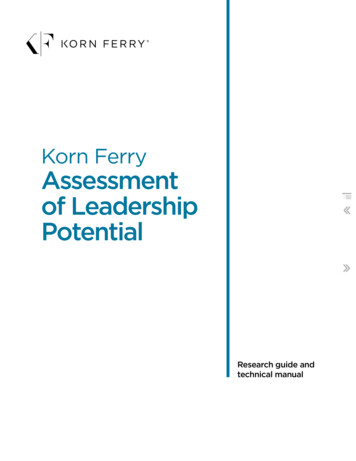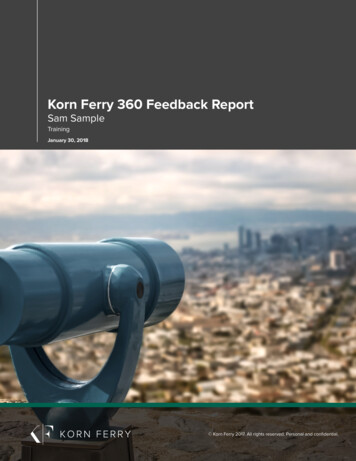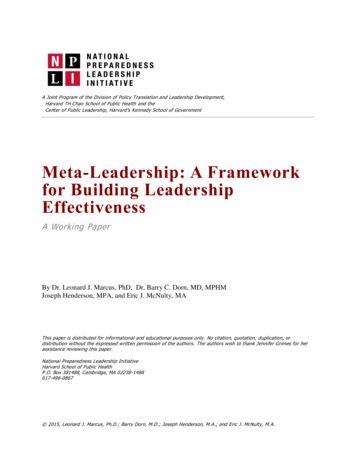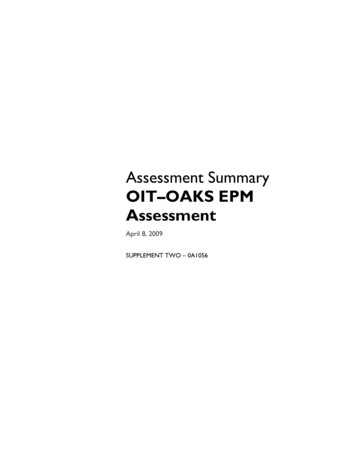
Transcription
Korn FerryAssessmentof LeadershipPotentialResearch guide andtechnical manual
Korn Ferry Assessment of Leadership PotentialResearch guide and technical manual Korn Ferry 2015-2016. All rights reserved.No part of this work may be copied or transferred to any otherexpression or form without a license from Korn Ferry.For the sake of linguistic simplicity in this product, where themasculine form is used, the feminine form should always beunderstood to be included.www.kornferry.comKorn Ferry Assessment of Leadership PotentialResearch guide and technical manualVersion 15.2a—05/2016
Korn FerryAssessmentof LeadershipPotentialResearch guide andtechnical manual
Table of contentsSection IIntroduction. 1Section IIIntroduction to high potential identification.3Business need.3What is leadership potential?.3Potential and Korn Ferry’s Four Dimensions of Leadership and Talent.6Korn Ferry’s model of leadership potential.8Section IIIThe Korn Ferry Assessment of Leadership Potential.10Overview.10Section IVThe Korn Ferry Assessment of Leadership Potential: Measurement approach.11Background.11Section VThe Korn Ferry Assessment of Leadership Potential: What it measures. 16Drivers. 16Experience. 21Traits. 23Awareness. 24Learning agility. 26Leadership traits. 27Capacity. 31Derailment risks. 32Section VIThe Korn Ferry Assessment of Leadership Potential: Uses, administration, scoring, andreporting overview. 34Intended uses. 34KFALP technical characteristics and validity. 36Norms.48Appendix A. Frequently asked questions.50Appendix B. Inter-method correlations. 55Appendix C. Norm descriptions. 56Appendix D. Global Personality Inventory (GPI) definitions. 68Appendix E. GPI and KFALP correlations. 70References. 71
Korn Ferry Assessment of Leadership Potential Research guide and technical manualSection IIntroductionThe Korn Ferry Assessment of Leadership Potential (KFALP) is a world-class, science-driven, and comprehensiveself-assessment for measuring leadership potential. The assessment measures an individual’s Drivers, Experience,Awareness, Learning agility, Leadership traits, Capacity, and Derailment risks. Norms are applied to provideinformation related to advancement to more senior leadership levels.Leadership potential is about what could be at some point in the future, not what is currently. By focusing onmeasures related to what could be, the tool has been carefully conceived and empirically designed to providecritical data about people—data proven to differentiate those who have successfully advanced from those whohave not advanced.The KFALP is designed to provide data important for individuals and organizations to consider as they thinkabout leadership potential. It is not designed for selection of individuals into specific jobs today, however, it canbe used as a data point for selection into roles where most hires are expected to further advance into leadershipwithin a relatively short time.This manual is designed as a technical reference to help deepen your understanding of the research behind theKFALP.You can refer to this manual for a variety of purposes: Build your knowledge regarding the research studies on high potential identification. Enhance your understanding of the research foundation of the KFALP. Review some key findings from psychometric analyses of KFALP data, including sub-group differences. Find answers to some frequently asked questions. Korn Ferry 2015–2016. All rights reserved.1
Korn Ferry Assessment of Leadership Potential Research guide and technical manualSection IIIntroduction to high potential identificationBusiness needToday, organizations face a unique and unprecedented set of challenges and potential opportunities. The pace ofmarket change, speed of innovation, global dynamics, and changing demographics generate many opportunitiesto both create and extract value, but it is often more difficult to locate those opportunities and act upon them.Thus, how do companies compete in this increasingly complex and volatile environment? One of the centraldifferentiators for companies is a strong human capital foundation: the right leaders in the right places.To succeed in driving business strategy, it is imperative for companies to have a future-focused talent strategy.Organizations need to develop and sustain a pipeline of the right leaders, with the right abilities, in the rightroles, and at the right times to ensure a sustainable competitive advantage. The idea of identifying andmanaging high potential talent has become increasingly essential for organizations.Most organizations have recognized the need for and have implemented a formal process to identify and assesshigh potential talent (Church & Rotolo, 2013; Silzer & Church, 2009). The construct of leadership potential, asused by many organizations, refers to the possibility that individuals have the qualities (e.g., motivation, skills,abilities, experiences, and characteristics) to advance in their careers and perform effectively in future roles. Itimplies further growth and development to reach some desired end state.According to several studies, only about one-half of companies report having a high potential identificationprogram (Howard, 2009; Slan-Jerusalim & Hausdorf, 2007; Wells, 2003). Companies which do have programsfrequently select individuals based on factors not necessarily related to potential, such as personal experiencewith the person, performance review ratings, and past performance results (Slan-Jerusalim & Hausdorf, 2007;Pepermans, Vloeberghs, & Perkisas, 2003). In addition, Martin and Schmidt (2010) indicated that based ontheir research on leadership transitions, nearly 40% of internal job moves made by people identified by theircompanies as “high potentials” end in failure.What is leadership potential?When comparing the way in which 13 major organizations defined potential, Karaevli and Hall (2003) foundthat every organization had a differing definition of the construct. Silzer and Church (2009) formed severalcommon potential definitions based on the results of a survey of organizations, finding that 35% definedpotential in terms of moving into a top leadership role, 25% defined it as having the potential to take on broaderresponsibilities and leadership duties, 10% viewed potential as having a history of being a high performer, and25% of organizations surveyed defined potential as successfully moving up two levels from the current level.With so many different perspectives and definitions of potential in use, it may be most useful to start by definingwhat potential is not.Potential is not the same as current job performance. Current performance is directly visible, but potential isa prediction about the future. Not all high performers are high potentials. Research suggests that only about30% of high performers should be classified as high potentials (Corporate Leadership Council, 2005). Althoughprevious performance can be a useful piece of information in the identification of high potential individuals, itshould not be (though, often is) confused with potential (Corporate Leadership Council, 2005; Slan-Jerusalim &Hausdorf, 2007; Pepermans, Vloeberghs, & Perkisas, 2003). Korn Ferry 2015–2016. All rights reserved.3
Korn Ferry Assessment of Leadership Potential Research guide and technical manualThe distinction between performance and potential is highlighted by the fact that the factors required forsuccessful performance changes from one organizational level to the next. The Charan, Drotter, and Noel (2011)six-passage model is often used to describe the leadership requirements throughout the various organizationallevels within a company. This “Pipeline Model of Leadership Development” defines the crucial skills for successfulmanagement transitions from the very bottom of an organization (managing oneself) to the very top (managingthe enterprise). Each of the six management transitions in this model, illustrated in Figure 1, involves a majorchange in job requirements, demanding new skills, time applications, and work values.Figure 1. The changing requirements of ECHNICAL SKILLSMANAGER OFMANAGERSBUSINESSUNIT LEADERLEADERSHIP AND MANAGEMENT SKILLSSENIOREXECUTIVESTRATEGIC BUSINESS ACUMENShort–termLimited stakeholdersManage tasksGet the job doneTransactionalCHIEFEXECUTIVELong–termMultiple stakeholdersManage portfolioMaximize shareholder valueTransformationalWhen advancing to leadership positions of greater responsibility, leadership roles increase in their challenge,breadth, and complexity. As leaders advance, they must reallocate their focus so that they can help others toperform effectively. They must learn to value the work of leadership and believe that making time for others,planning, coordinating, and coaching are imperative in their new responsibility. Strong performance at one leveldoes not necessarily indicate the capability to successfully progress to more complex future leadership roles.Potential is also not a person’s readiness at present to move into an immediate next-level position or promotion.Potential is a more long-term concept, and individuals being considered for an immediate next level should beassessed using Korn Ferry’s readiness assessments instead.Another important question frequently asked when discussing the identification of high potential individuals ispotential for what? Everyone has potential, but to what end (Silze
Leadership skills include developing others, leading and managing others, and influencing and inspiring. Motivation variables include energy, engagement, drive for advancement, career drive, interests, career aspirations, results orientation, and risk taking. Performance record includes leadership experiences and performance track record.











